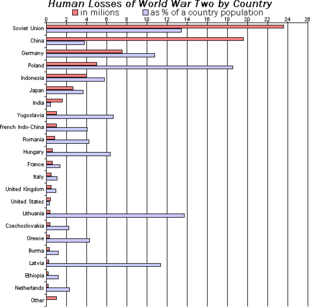Bar chart

A bar chart or bar graph is a chart or graph that presents categorical data with rectangular bars with heights or lengths proportional to the values that they represent. The bars can be plotted vertically or horizontally. A vertical bar chart is sometimes called a column chart.
A bar graph shows comparisons among discrete categories. One axis of the chart shows the specific categories being compared, and the other axis represents a measured value. Some bar graphs present bars clustered in groups of more than one, showing the values of more than one measured variable.
History
Many sources consider William Playfair (1759-1824) to have invented the bar chart and the Exports and Imports of Scotland to and from different parts for one Year from Christmas 1780 to Christmas 1781 graph from his The Commercial and Political Atlas to be the first bar chart in history. Diagrams of the velocity of a constantly accelerating object against time published in The Latitude of Forms (attributed to Jacobus de Sancto Martino or, perhaps, to Nicole Oresme)[1] about 300 years before can be interpreted as "proto bar charts".[2][3]
Usage

Bar charts have a discrete domain of categories, and are usually scaled so that all the data can fit on the chart. When there is no natural ordering of the categories being compared, bars on the chart may be arranged in any order. Bar charts arranged from highest to lowest incidence are called Pareto charts.
Bar graphs/charts provide a visual presentation of categorical data.[4] Categorical data is a grouping of data into discrete groups, such as months of the year, age group, shoe sizes, and animals. These categories are usually qualitative. In a column bar chart, the categories appear along the horizontal axis; the height of the bar corresponds to the value of each category.
Grouped and stacked
Bar graphs can also be used for more complex comparisons of data with grouped bar charts and stacked bar charts.[4] In a grouped bar chart, for each categorical group there are two or more bars. These bars are color-coded to represent a particular grouping. example, a business owner with two stores might make a grouped bar chart with different colored bars to represent each store: the horizontal axis would show the months of the year and the vertical axis would show the revenue. Alternatively, a stacked bar chart could be used. The stacked bar chart stacks bars that represent different groups on top of each other. The height of the resulting bar shows the combined result of the groups. However, stacked bar charts are not suited to data sets where some groups have negative values. In such cases, grouped bar chart are preferable.
Grouped bar graphs usually present the information in the same order in each grouping. Stacked bar graphs present the information in the same sequence on each bar.
See also
- See Extension:EasyTimeline to include bar charts in Wikipedia.
- Enhanced Metafile Format to use in office suits, as MS PowerPoint.
- Histogram, similar appearance - for continuous data
- Misleading graph
References
- ^ Clagett, Marshall (1968), Nicole Oresme and the Medieval Geometry of Qualities and Motions, Madison: Univ. of Wisconsin Press, pp. 85–99, ISBN 0-299-04880-2
- ^ Beniger, James R.; Robyn, Dorothy L. (1978), "Quantitative Graphics in Statistics: A Brief History", The American Statistician, 32 (1), Taylor & Francis, Ltd.: 1–11, doi:10.1080/00031305.1978.10479235, JSTOR 2683467
- ^ Der, Geoff; Everitt, Brian S. (2014). A Handbook of Statistical Graphics Using SAS ODS. Chapman and Hall - CRC. ISBN 1-584-88784-2.
- ^ a b Kelley, W. M.; Donnelly, R. A. (2009) The Humongous Book of Statistics Problems. New York, NY: Alpha Books ISBN 1592578659
External links
- Directory of graph software and online tools (many can handle bar charts)
